Differentiation in neuroblastoma: diffusion-limited hypoxia induces neuro-endocrine secretory protein 55 and other markers of a chromaffin phenotype
- PMID: 20862257
- PMCID: PMC2941466
- DOI: 10.1371/journal.pone.0012825
Differentiation in neuroblastoma: diffusion-limited hypoxia induces neuro-endocrine secretory protein 55 and other markers of a chromaffin phenotype
Abstract
Background: Neuroblastoma is a childhood malignancy of sympathetic embryonal origin. A high potential for differentiation is a hallmark of neuroblastoma cells. We have previously presented data to suggest that in situ differentiation in tumors frequently proceeds along the chromaffin lineage and that decreased oxygen (hypoxia) plays a role in this. Here we explore the utility of Neuro-Endocrine Secretory Protein 55 (NESP55), a novel member of the chromogranin family, as a marker for this process.
Methodology/principal findings: Immunohistochemical analyses and in situ hybridizations were performed on human fetal tissues, mouse xenografts of human neuroblastoma cell lines, and on specimens of human neuroblastoma/ganglioneuroma. Effects of anaerobic exposure on gene expression by cultured neuroblastoma cells was analyzed with quantitative real-time PCR. Fetal sympathetic nervous system expression of NESP55 was shown to be specific for chromaffin cell types. In experimental and clinical neuroblastoma NESP55 immunoreactivity was specific for regions of chronic hypoxia. NESP55 expression also correlated strikingly with morphological evidence of differentiation and with other chromaffin-specific patterns of gene expression, including IGF2 and HIF2α. Anaerobic culture of five neuroblastoma cell lines resulted in an 18.9-fold mean up-regulation of NESP55.
Conclusions/significance: The data confirms that chronic tumor hypoxia is a key microenvironmental factor for neuroblastoma cell differentiation, causing induction of chromaffin features and NESP55 provides a reliable marker for this neuronal to neuroendocrine transition. The hypoxia-induced phenotype is the predominant form of differentiation in stroma-poor tumors, while in stroma-rich tumors the chromaffin phenotype coexists with ganglion cell-like differentiation. The findings provide new insights into the biological diversity which is a striking feature of this group of tumors.
Conflict of interest statement
Figures
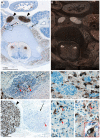

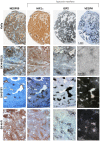
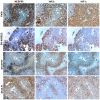
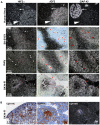
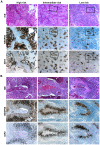
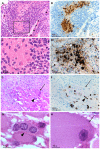


Similar articles
-
Evidence for hypoxia-induced neuronal-to-chromaffin metaplasia in neuroblastoma.FASEB J. 2003 Apr;17(6):598-609. doi: 10.1096/fj.02-0390com. FASEB J. 2003. PMID: 12665472
-
IGF2 expression is a marker for paraganglionic/SIF cell differentiation in neuroblastoma.Am J Pathol. 1995 Apr;146(4):833-47. Am J Pathol. 1995. PMID: 7717451 Free PMC article.
-
Distribution and intraneuronal trafficking of a novel member of the chromogranin family, NESP55, in the rat peripheral nervous system.Neuroscience. 2002;110(4):731-45. doi: 10.1016/s0306-4522(01)00465-1. Neuroscience. 2002. PMID: 11934480
-
Hypoxia-induced dedifferentiation of tumor cells--a mechanism behind heterogeneity and aggressiveness of solid tumors.Semin Cell Dev Biol. 2005 Aug-Oct;16(4-5):554-63. doi: 10.1016/j.semcdb.2005.03.007. Epub 2005 Apr 26. Semin Cell Dev Biol. 2005. PMID: 16144692 Review.
-
Hypoxia-induced dedifferentiation in neuroblastoma cells.Cancer Lett. 2003 Jul 18;197(1-2):145-50. doi: 10.1016/s0304-3835(03)00095-8. Cancer Lett. 2003. PMID: 12880974 Review.
Cited by
-
Favorable prognostic role of tropomodulins in neuroblastoma.Oncotarget. 2018 Jun 5;9(43):27092-27103. doi: 10.18632/oncotarget.25491. eCollection 2018 Jun 5. Oncotarget. 2018. PMID: 29930753 Free PMC article.
-
CD44+ fibroblasts increases breast cancer cell survival and drug resistance via IGF2BP3-CD44-IGF2 signalling.J Cell Mol Med. 2017 Sep;21(9):1979-1988. doi: 10.1111/jcmm.13118. Epub 2017 May 18. J Cell Mol Med. 2017. PMID: 28523716 Free PMC article.
-
The ETS transcription factor ETV5 is a target of activated ALK in neuroblastoma contributing to increased tumour aggressiveness.Sci Rep. 2020 Jan 14;10(1):218. doi: 10.1038/s41598-019-57076-5. Sci Rep. 2020. PMID: 31937834 Free PMC article.
-
The evolutionary biology of child health.Proc Biol Sci. 2011 May 22;278(1711):1441-9. doi: 10.1098/rspb.2010.2627. Epub 2011 Feb 2. Proc Biol Sci. 2011. PMID: 21288946 Free PMC article. Review.
-
Hypoxia in the Initiation and Progression of Neuroblastoma Tumours.Int J Mol Sci. 2019 Dec 19;21(1):39. doi: 10.3390/ijms21010039. Int J Mol Sci. 2019. PMID: 31861671 Free PMC article. Review.
References
-
- Brodeur G, Sawada T, Tsuchida Y, Voûte P, editors. Amsterdam: Elsevier; 2000. Neuroblastoma.582
-
- Reynolds CP, Matthay KK, Villablanca JG, Maurer BJ. Retinoid therapy of high-risk neuroblastoma. Cancer Lett. 2003;197:185–192. - PubMed
-
- Pahlman S, Mamaeva S, Meyerson G, Mattsson ME, Bjelfman C, et al. Human neuroblastoma cells in culture: a model for neuronal cell differentiation and function. Acta Physiol. 1990;Scand(Suppl 592):25–37. - PubMed
-
- Liu S, Tian Y, Chlenski A, Yang Q, Salwen HR, et al. ‘Cross-talk’ between Schwannian stroma and neuroblasts promotes neuroblastoma tumor differentiation and inhibits angiogenesis. Cancer Lett. 2005;228:125–131. - PubMed
-
- Schramm A, Schulte JH, Astrahantseff K, Apostolov O, Limpt V, et al. Biological effects of TrkA and TrkB receptor signaling in neuroblastoma. Cancer Lett. 2005;228:143–153. - PubMed
Publication types
MeSH terms
Substances
LinkOut - more resources
Full Text Sources
Medical
Molecular Biology Databases
Miscellaneous

